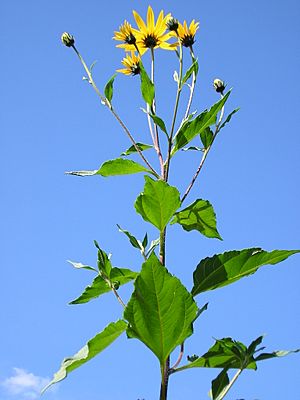Jerusalem artichoke facts for kids
The artichoke is a different plant
Quick facts for kids Jerusalem artichoke |
|
|---|---|
 |
|
| Stem with flowers | |
| Scientific classification | |
| Kingdom: | |
| (unranked): | |
| (unranked): | |
| (unranked): | |
| Order: | |
| Family: | |
| Tribe: | |
| Genus: | |
| Species: |
H. tuberosus
|
| Binomial name | |
| Helianthus tuberosus |
|
The Jerusalem artichoke (Helianthus tuberosus), also known as sunroot, sunchoke, earth apple, or topinambour, is a type of sunflower. It grows naturally in eastern North America, from eastern Canada and Maine all the way west to North Dakota, and south to northern Florida and Texas. People also grow it widely in places with moderate climates because of its special underground part called a tuber, which is eaten as a root vegetable.
Contents
About the Jerusalem Artichoke Plant
This plant is a perennial herbaceous plant, which means it lives for more than two years and has soft stems instead of woody ones. It can grow very tall, sometimes up to 3 metres (9.8 ft) (about 10 feet) high! Its leaves are oval-shaped and can be 7 centimetres (2.8 in) to 10 centimetres (3.9 in) (about 3 to 4 inches) wide, and 10 centimetres (3.9 in) to 25 centimetres (9.8 in) (about 4 to 10 inches) long.
When the Jerusalem artichoke was brought to Europe, it sometimes became an invasive species. This means it grew so much that it took over areas, leaving little room for other plants. Not many animals eat it, which allowed it to spread very quickly without being controlled.
What the Plant is Used For
The Jerusalem artichoke has many uses! It has been used to make different kinds of drinks and sugar. It's also a food source for animals like horses and pigs.
Interestingly, this plant can be helpful for people with diabetes. Up to 16% of the plant is made of a special type of polysaccharide called inulin. Inulin is a kind of fiber that doesn't raise blood sugar levels as much as other sugars, which can be good for managing diabetes.
A Tricky Business Idea
In the 1980s, the Jerusalem artichoke became known for a different reason. Some farmers in the midwestern United States were encouraged to plant its seeds as part of a business plan that turned out to be a pyramid scheme. At the time, there wasn't much demand for the plant's tubers in that area. However, farmers were told that the plant would soon be a popular item to sell.
In a pyramid scheme, only the first people involved and a few levels of early sellers make money by selling seeds to new people joining the scheme. Later on, many farmers who planted a lot of the crop found it hard to sell, and they didn't make the profits they expected.
Images for kids
See also
 In Spanish: Tupinambo para niños
In Spanish: Tupinambo para niños





